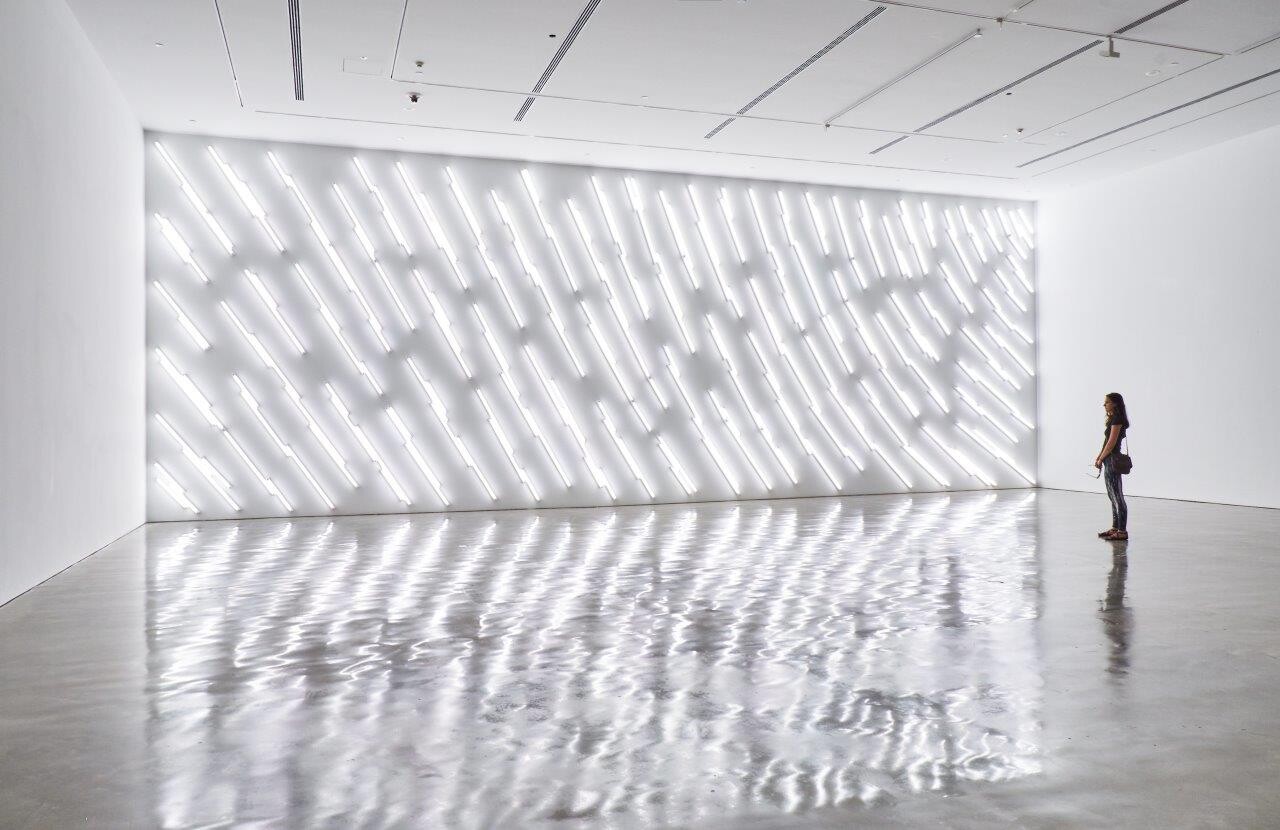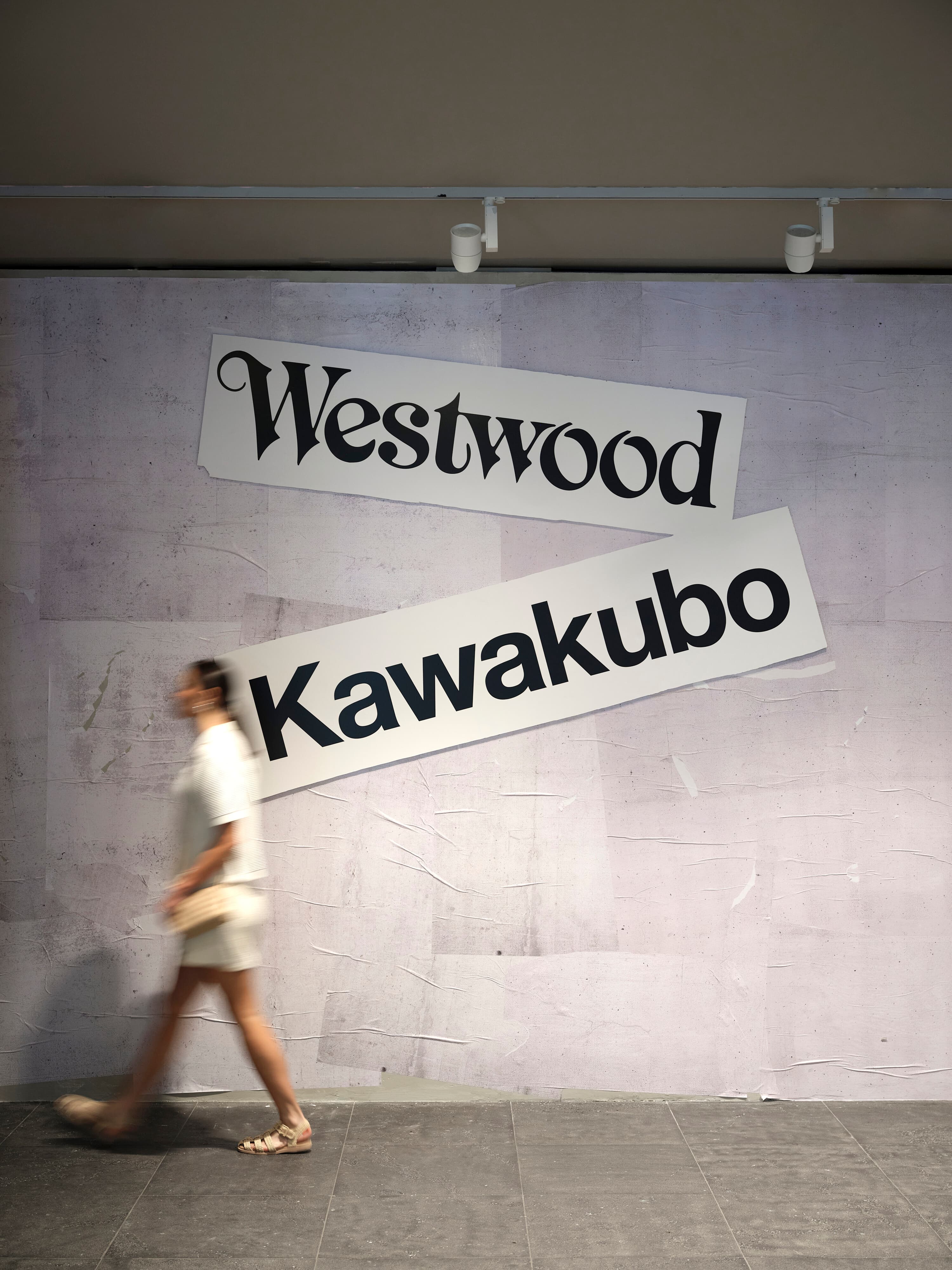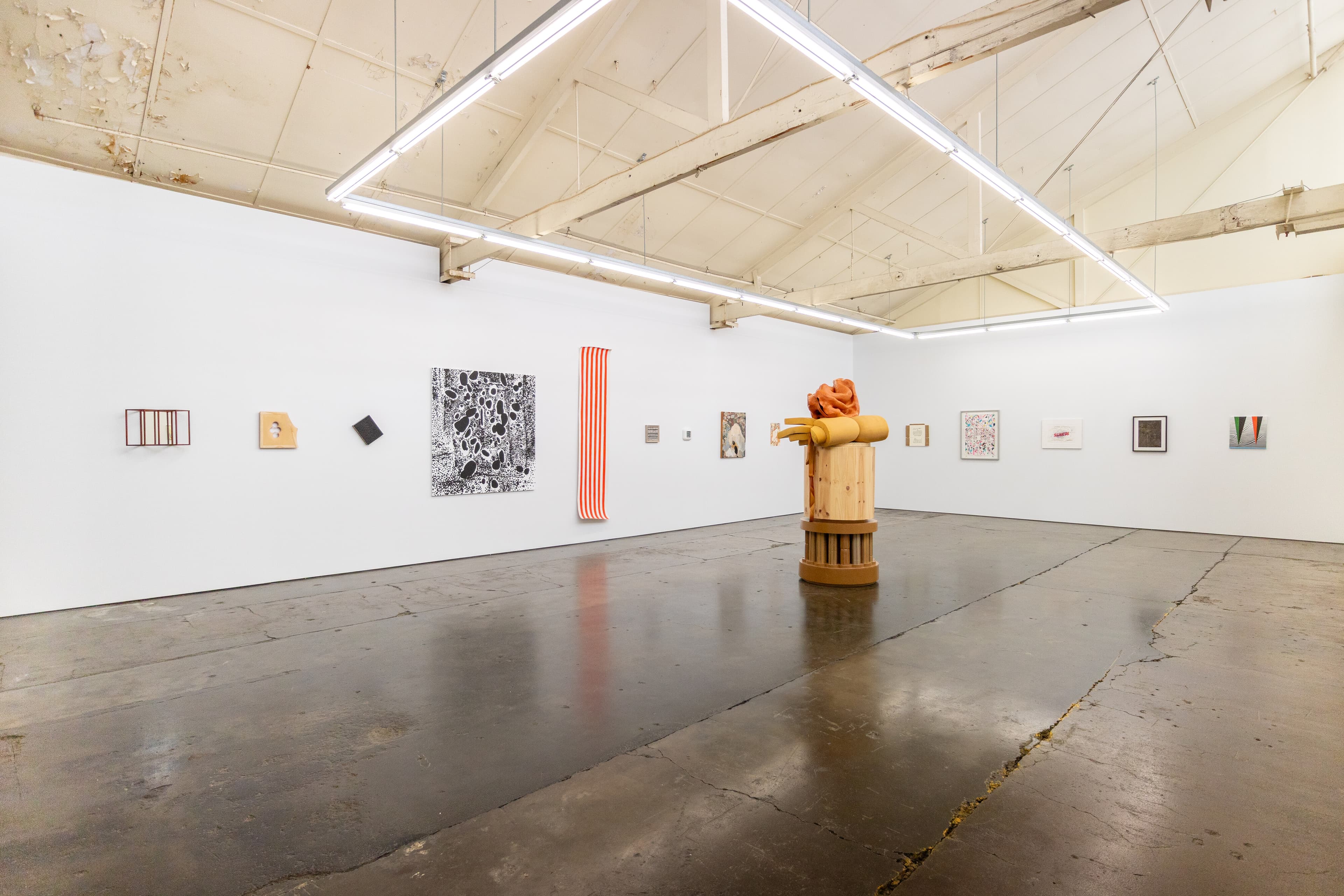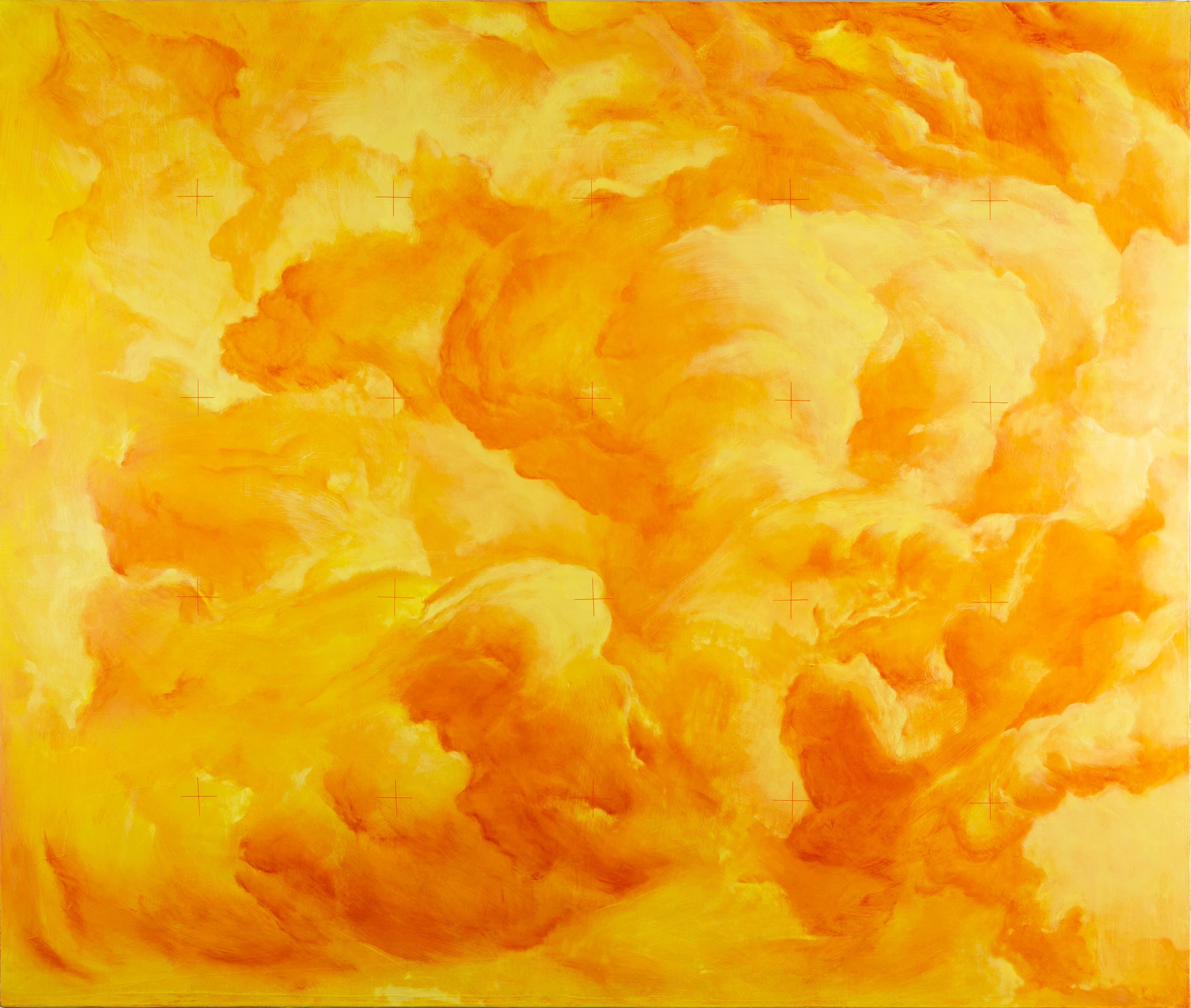Jonathan Jones, naa (to see or look), 2015, fluorescent tubes, fittings, electrical cable, Museum of Contemporary Art Australia, purchased with funds provided by the MCA Foundation, 2015, image courtesy and © the artist, photograph: Christopher Snee.
naa, (to see or look) (2015)
Jaye Early
Revealing his undeniable awe for Jean Baptiste Siméon Chardin’s enigmatic painting, The Ray (1728), Henri Cartier-Bresson once pithily told American architecture critic Michael Kimmelman, “I don’t say understand; I say feel.” I largely adopted Cartier-Bresson’s recommendation when viewing naa (to see or look) (2015)—an impressive, large-scale, site-specific, light installation by Wiradjuri and Kamilaroi artist Johnathan Jones, which is currently on display at the Museum of Contemporary Art (MCA) in Sydney. I say “largely” because often when viewing Jones’s work an eager curiosity leaves me with a desire to know a little bit more beyond my initial (but lasting) sense of reverence. I can think, for instance, Jones’s unforgettable, large-scale sculptural installation, barrangal dyara (skin and bones) (2016). Another occasion when my curiosity exceeded my reverence occurred earlier this year when I first witnessed Jones’s untitled (emu eggs) after Étienne Pierre Ventenat (2021-23), and untitled (vases, armes, pêches) (2023) in an exhibition titled untitled (transcriptions of country) at Artspace in Sydney. In this instance, when viewing naa (to see or look), I needed to (mostly) understand, not just feel. Originally exhibited at the MCA in 2015, naa (to see or look) is now part of the MCA’s contemporary art collection. Compared to the State and National Galleries, the MCA’s collection of contemporary art focuses on art made by living artists, both established and emerging, with a third of the collection made up of notable Aboriginal and Torres Strait Islander artists, including Mabel Anaka-annaburra, Paddy Bedford (Nyunkuny), Ngamaru Bidu, Bowja Patricia Butt (and several other Martu artists), David Malangi Daymirringu, Fiona Foley, and Mirdidingkingathi Juwarnda Sally Gabori.
Through its sheer scale, naa (to see or look) radiates a hypnotic and dazzling authority over its miniaturised onlookers with a nuanced and somehow subdued resonance. This subdued resonance results from the ease with which both natural and artificial light seems effortlessly to saturate the space with a warm simplicity and delicacy that somehow challenges the sterility and harshness often associated with artificial fluorescent tube lighting. Jones utilises light, space, and scale as a structuring device to encourage viewer participation and to gently incite curiosity and engagement with his works. Standing alone in the MCA’s impressive first-floor, double-height space, leaning back against the far wall in front of the work, I suddenly and unexpectedly begin to feel what I can only describe as a commending sense of loss and grief. Wanting to explore these unexpected feelings, I momentarily set aside my initial reverence and redirected my attention to thematically contextualising and unpacking some of the intensions behind the work. naa (to see or look) observes a singular moment in time when an improbable collision took place between two very different worlds: the world’s oldest living culture and the disreputable, late-eighteenth century, British Empire. More specifically, the collision between Patyegarang (grey kangaroo), thought to be a Gamaraigal women from the Dharug clan, and William Nicolas Dawes (1762–1836), a curious colonial administrator and second lieutenant of the British marines. When describing this collision, or unlikely friendship, researchers and historians tell of a friendship based on genuine, mutual respect, and equal power relations. Regarding the latter description, I remain unconvinced. Admittedly though, there is a certain inarticulate buoyancy I feel when imagining that such an unlikely friendship triumphed out of, quite obviously, the most unequal of power relations. My thoughts briefly dwell on this idea of power relations, particularly the systemic and everyday power relations between contemporary First Nations people and non-First Nations people. What hurriedly came to mind is a deep and agonisingly violent chasm between the two. From my observations, relationships between First Nations people and non-First Nations people that are built on and around mutual respect and equal power relations are, unfortunately, the exception in contemporary Australia. This perhaps explains my unexpected and commanding sense of loss and grief.

Jonathan Jones, naa (to see or look), 2015, fluorescent tubes, fittings, electrical cable, Museum of Contemporary Art Australia, purchased with funds provided by the MCA Foundation, 2015, image courtesy and © the artist, photograph: Christopher Snee.
Volunteering for service on the first fleet, William Nicolas Dawes—whose life Jones’s installation largely draws inspiration from—was an accomplished surveyor, scientist, and astronomer. Dawes’s accomplishments as an astronomer led to the construction of the observatory at Tarra/Dawes Point in Warrane/Sydney Cove—the site where the MCA stands today. It was here that Dawes documented his interactions with the Aboriginal people of the Eora Nation, resulting in a number of notebooks reflecting his regard and genuine inquisitiveness for Gadigal culture and knowledge systems, particularly, Gadigal language.
In a 2015 MCA interview, now available on YouTube, Jones reveals that Naa—a local word meaning to see or look—is the first word that appears in one of Dawes’s notebooks. Intriguingly, Dawes’s notebooks are unlike other traditional, more clinical, colonial-era notebooks in that many of the observations he made about the Gadigal people prioritised casual and personable interactions. Here, he focused on documenting specific individuals, their emotions, and unique personalities. There is a sense that Dawes was wanting to humanise his interactions with Aboriginal people of the Eora Nation. Patyegarang’s Gadigal language teachings provided Dawes with a rich insight into Patyegarang’s world, including Gadigal cosmology and the complex knowledge systems that are connected to Songlines and the Dreaming. In the process, he learnt that, through oral tradition and ceremony, the land and the sky for the Gadigal people—and for many other Aboriginal and Torres Strait Islander nations—were seen as a reflection of each other. By allowing Dawes to document their interactions, Patyegarang unknowingly not only inadvertently guaranteed the survival of the Gadigal language, but arguably—according to the work of many historians—became Australia’s first Indigenous linguist. For all her generosity, Patyegarang remains a profoundly critical figure in Aboriginal and Torres Strait Islander history.

Jonathan Jones, naa (to see or look), 2015, fluorescent tubes, fittings, electrical cable, Museum of Contemporary Art Australia, purchased with funds provided by the MCA Foundation, 2015, image courtesy and © the artist, photgraph: Christopher Snee.
According to Jones, each individual light in the installation represents both a star and a word. Starting with the seemingly simple act of looking, Jones delves into the parallels between stars and language in naa (to see or look). In particular, the way that stars seem to morph into language as they navigate their way across the dark skies, engaging in intricate forms of communication with those below. Embracing light as a poetic metaphor for stars and words, Jones is wanting to not only bring the past into the present, he is also quite literally attempting to illuminate the connections between two vastly different cultures against a display of celestial grandeur. Within this, the work can be seen as emblematic of the friendship between Patyegarang and Dawes. This was expressively revealed to me when studying the brightened concrete floor in front of the work. It is here that a watery, smudgy, rhythmical dance takes place within a reflective, illumined, interplay of light and dark. This connectedness between land and sky, light and dark, is an unlikely friendship, and the harmonious clash of cultural epistemologies reveals what curator Natasha Bullock writes is “a different way of seeing, translating past symbols and stories into allegories of hope about future possibilities.”
Admittedly, this hope for future possibilities that Bullock expresses doesn’t entirely quell my lingering feelings of loss and grief, and the scepticism I maintain regarding the despairing realities of contemporary Aboriginal and Torres Strait Islander people. And a part of me understands that it is not meant to. However, I cannot deny that somewhere deep down within me there exist glimmers of hope for future possibilities. And, on occasion, as previously mentioned, such glimmers of hope do unexpectedly surface in the form of fleeting moments of buoyancy when imagining, in this instance, what could be from what was. This is what I choose to take away from Jones’s remarkable installation.

Jonathan Jones, naa (to see or look), 2015, fluorescent tubes, fittings, electrical cable, Museum of Contemporary Art Australia, purchased with funds provided by the MCA Foundation, 2015, image courtesy and © the artist, photograph: Christopher Snee.
Another success of Jones’s installation is its ability to subtly explore lyrical interactions between the individual and community and, as an extension of this, a collective, broader national community. This is where Jones is encouraging active viewer participation, rather than passive observation. Not only with the history and the subtle cultural resilience embedded within the work, but also the physicality of the work—its immense scale and the nuanced illumination of its surrounds. In other words, an active engagement with light and physical space, and the installation’s allegorical and metaphorical engagement with both. From this, an opportunity is extended to the viewer to contemplate wider socio-political themes. For instance, historical, non-Indigenous constructions of settlor-colonial identity and memory. Specifically, how we collectively as a nation acknowledge, comprehend, and respect Aboriginal and Torres Strait Islander culture and history in contemporary Australia. This sense of immersion and contemplation is where great moments happen.
Overall, the success of any artwork is when it unobtrusively reiterates the moments where it is difficult to conceal any restive sense of disinclination. Jones’s endlessly inspiring curiosity for the social and cultural relationships that connect people with place—combined with his skilful, clever, and meticulously crafted visual strategies —is a guarantee that a restive sense of disinclination, almost always, never happens.
Jaye Early is a Dharug man, visual artist and Lecturer at UNSW Art & Design


